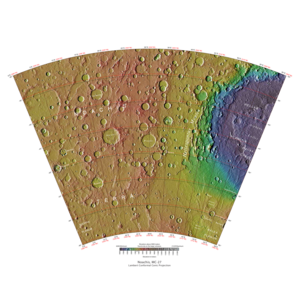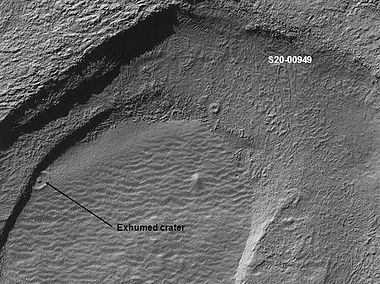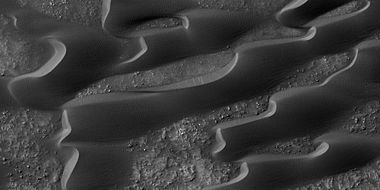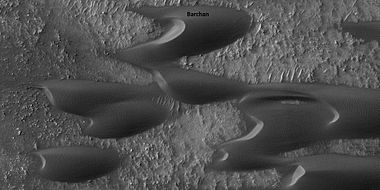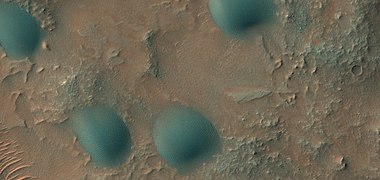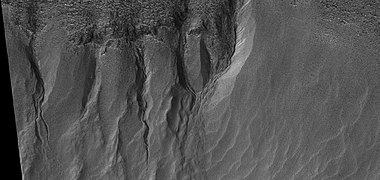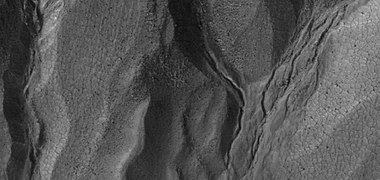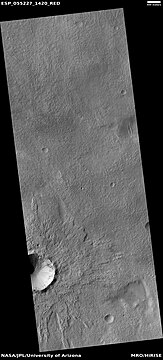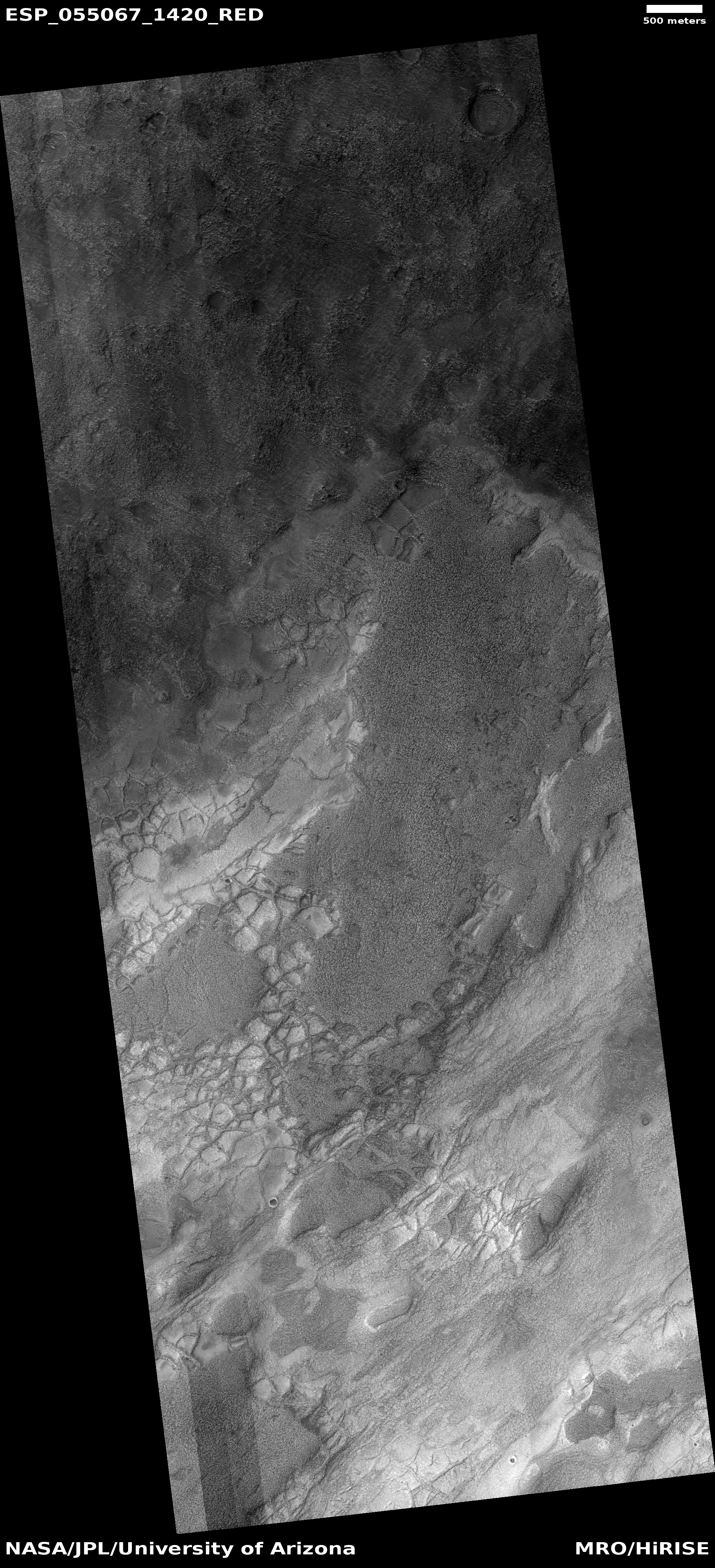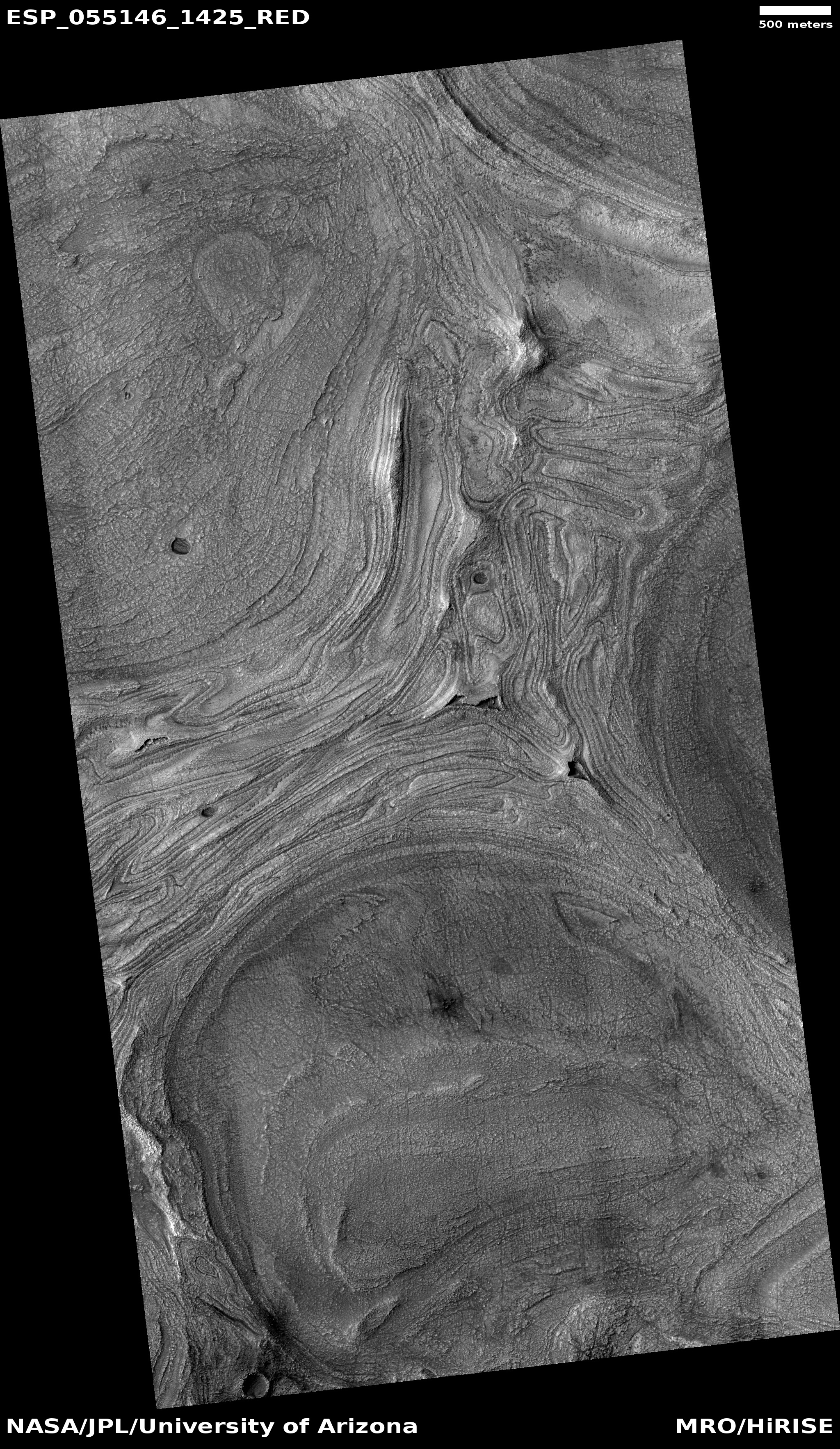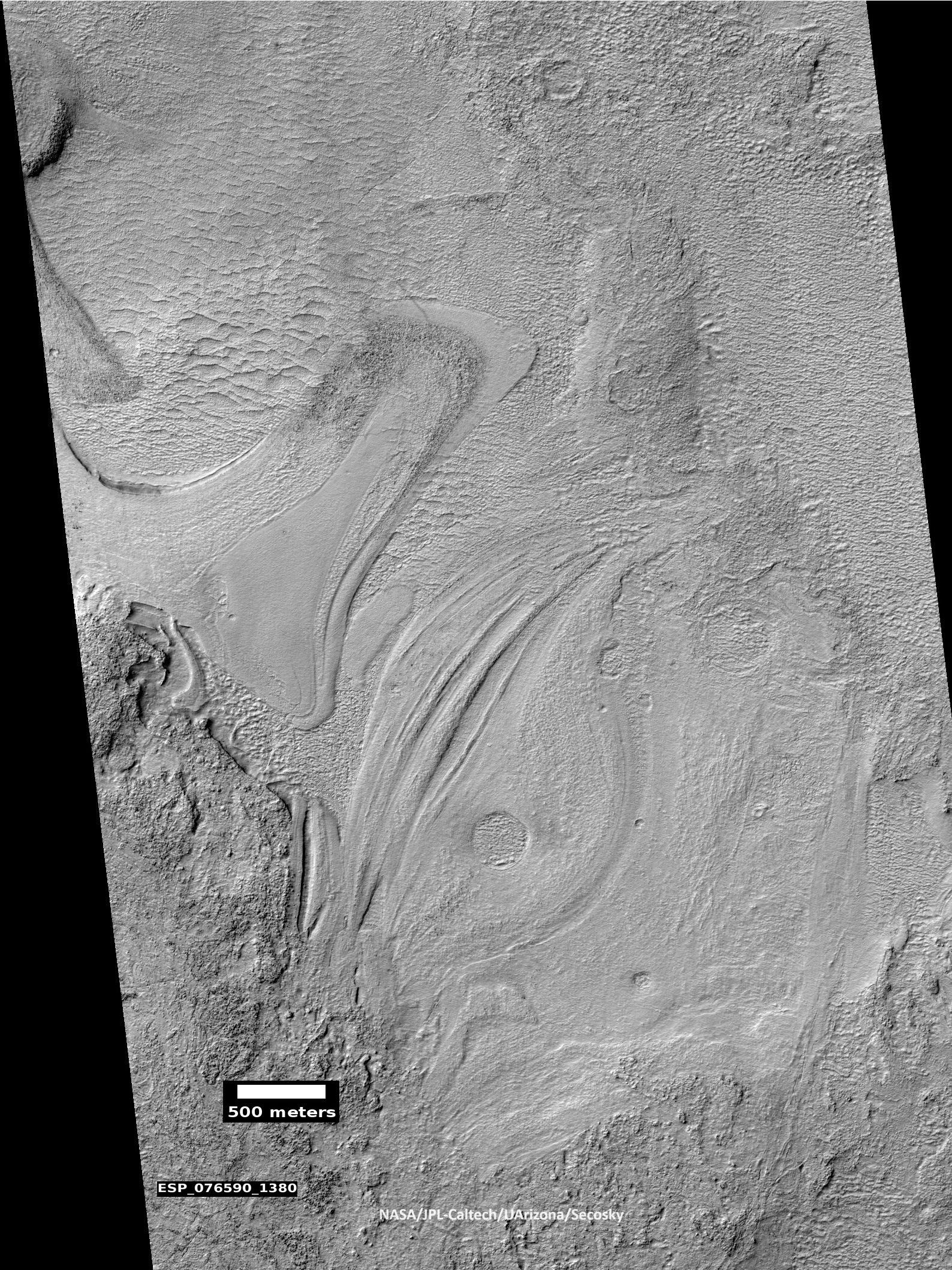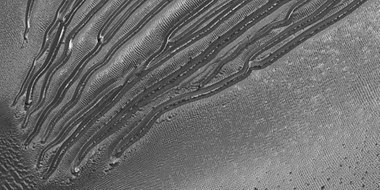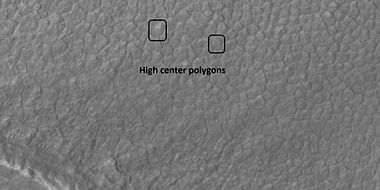Difference between revisions of "Noachis quadrangle"
Suitupshowup (talk | contribs) (→Craters: added image) |
|||
| (45 intermediate revisions by 2 users not shown) | |||
| Line 14: | Line 14: | ||
</gallery> | </gallery> | ||
[[Category: Mars Atlas]] | [[Category: Mars Atlas]] | ||
| + | |||
| + | The Noachis quadrangle covers the area from 30° to 65° south latitude and 300° to 360° west longitude (60-0 E). It lies between Argyre and Hellas, two giant impact basins on Mars. The Noachis quadrangle includes Noachis Terra and the western part of Hellas Planitia, which are classical names for regions on Mars. The name "Noachis" means the land of Noah. | ||
| + | Noachis is considered among the oldest regions on Mars since it is so densely covered with impact craters. The oldest parts of Mars have the designation of “Noachian age." | ||
| + | In addition, many previously buried craters are now coming to the surface.<ref>http://themis.asu.edu/zoom-20040317a|title=Exhumed Crater (Released 17 March 2004)|author=Mars Space Flight Facility|date=17 March 2004|publisher=Arizona State University|</ref> Noachis' extreme age has allowed ancient craters to be filled, and once again become newly exposed. | ||
| + | Much of the surface in Noachis quadrangle shows a scalloped topography in which the disappearance of ground ice has left depressions.<ref>Lefort | first1 = A. | display-authors = etal | year = 2010 | title = Scalloped terrains in the Peneus and Amphitrites Paterae region of Mars as observed by HiRISE | url = | journal = Icarus | volume = 205 | issue = 1| pages = 259–268 | </ref> | ||
| + | The first piece of human technology to land on Mars landed (crashed) in the Noachis quadrangle. It was the Soviet's Mars 2 that crash landed at 44.2 S and 313.2 W. It weighed about one ton. The automated craft attempted to land in a giant dust storm and in an area that has many dust devils.<ref>Hartmann, W. 2003. A Traveler's Guide to Mars. Workman Publishing. NY, NY.</ref> | ||
| + | |||
| + | In this article, some of the best pictures from a number of spacecraft will show what the landscape looks like in this region. The origins and significance of all features will be explained as they are currently understood. | ||
| + | |||
| + | ==Scalloped topography== | ||
| + | |||
| + | |||
| + | Certain regions of Mars display scalloped-shaped depressions. The depressions are believed to be the remains of an ice-rich mantle deposit. Scallops are created when ice sublimates from frozen soil.<ref>https://www.uahirise.org/PSP_004340_1235 | title=HiRISE | Scalloped Depressions in Peneus Patera (PSP_004340_1235)}}</ref> <ref>McEwen, A., et al. 2017. Mars The Pristine Beauty of the Red Planet. University of Arizona Press. Tucson.</ref> This mantle material probably fell from the air as ice formed on dust when the climate was different due to changes in the tilt of the Mars pole.<ref>doi=10.1038/nature02114 |pmid=14685228 |title=Recent ice ages on Mars |journal=Nature |volume=426 |issue=6968 |pages=797–802 |year=2003 |last1=Head |first1=James W. |last2=Mustard |first2=John F. |last3=Kreslavsky |first3=Mikhail A. |last4=Milliken |first4=Ralph E. |last5=Marchant |first5=David R. |</ref> The scallops are typically tens of meters deep and from a few hundred to a few thousand meters across. They can be almost circular or elongated. Some appear to have coalesced, thereby causing a large heavily pitted terrain to form. A study published in Icarus, found that the landforms of scalloped topography can be made by the subsurface loss of water ice by sublimation under current Martian climate conditions. This model predicts similar shapes when the ground has large amounts of pure ice, up to many tens of meters in depth.<ref> |doi=10.1016/j.icarus.2015.07.033 |title=Modeling the development of martian sublimation thermokarst landforms |journal=Icarus |volume=262 |pages=154–169 |year=2015 |last1=Dundas |first1=Colin M. |last2=Byrne |first2=Shane |last3=McEwen |first3=Alfred S. |https://zenodo.org/record/1259051/files/article.pdf </ref> | ||
| + | The process of producing the terrain may begin with sublimation from a crack because there are often polygon cracks where scallops form.<ref > Lefort, A.; et al. (2010). "Scalloped terrains in the Peneus and Amphitrites Paterae region of Mars as observed by HiRISE". Icarus. 205 (1): 259–268.</ref> In other words, when we see this type of surface, we know there is probably ice in the ground. Future astronauts may mine this terrain for water. | ||
| + | |||
| + | <gallery class="center" widths="380px" heights="360px"> | ||
| + | |||
| + | 4340 1235scalloped.jpg|Close view of scalloped topography, as seen by HiRISE | ||
| + | |||
| + | ESP 050728 1210scalloped.jpg|Scalloped topography, as seen by HiRISE under HiWish program | ||
| + | |||
| + | </gallery> | ||
| + | |||
| + | == Dust Devil Tracks == | ||
| + | |||
| + | [[File:ESP 050715 1225devilsscallops.jpg|600pxr|Dust devil tracks and scalloped topography, as seen by HiRISE under [[HiWish program]]]] | ||
| + | Dust devil tracks and scalloped topography, as seen by HiRISE under [[HiWish program]] | ||
| + | |||
| + | Many areas on Mars experience the passage of giant dust devils. A thin coating of fine bright dust covers most of the Martian surface. When a dust devil goes by it blows away the coating and exposes the underlying dark surface creating tracks. It does not take too much fine dust to cover those tracks--experiments in Earth laboratories demonstrate that only a few 10's of microns of dust will be enough. The width of a single human hair ranges from approximately 20 to 200 microns (μm); consequently, the dust that can cover dust devil tracks may only be the thickness of a human hair.<ref>https://en.wikipedia.org/wiki/Micrometre</ref> Dust devils have been seen from the ground and from orbit. They have even blown the dust off of the solar panels of the two Mars Exploration Rovers (Spirit and Opportunity), thereby greatly extending their lives.<ref>http://marsrovers.jpl.nasa.gov/gallery/press/spirit/20070412a.html|publisher=National Aeronautics and Space Administration</ref> The twin Rovers were designed to last for 3 months, instead they lasted many years with Opportunity lasting over 14 years. The pattern of the dust devil tracks have been shown to change every few months.<ref>https://web.archive.org/web/20111028015730/http://mars.jpl.nasa.gov/spotlight/kenEdgett.html |</ref> One study that combined data from the High Resolution Stereo Camera (HRSC) and the Mars Orbiter Camera (MOC) found that some large dust devils on Mars have a diameter of 700 meters and last at least 26 minutes.<ref>doi=10.1016/j.icarus.2011.06.011 |title=Multitemporal observations of identical active dust devils on Mars with the High Resolution Stereo Camera (HRSC) and Mars Orbiter Camera (MOC) |journal=Icarus |volume=215 |issue=1 |pages=358–369 |year=2011 |last1=Reiss |first1=D. |last2=Zanetti |first2=M. |last3=Neukum |first3=G. |</ref> The image below of Russel Crater shows changes in dust devil tracks over a period of only three months, as documented by HiRISE. | ||
| + | |||
| + | <gallery class="center" widths="380px" heights="360px"> | ||
| + | |||
| + | Image:Russel Crater Dust Devil Changes.JPG|Russell Crater Dust Devil Changes, as seen by HiRISE. The pictures show that major changes in dust devil tracks happened in just 3 months. | ||
| + | |||
| + | </gallery> | ||
| + | |||
| + | ==Craters== | ||
| + | |||
| + | <gallery class="center" widths="380px" heights="360px"> | ||
| + | |||
| + | Image:Asimov Layers Close-up.JPG|Close-up of layers in west slope of Asimov Crater. Shadows show the overhang. Some of the layers are much more resistant to erosion, so they stick out. Image from HiRISE. | ||
| + | |||
| + | Image:Kaiser Crater.JPG|Kaiser Crater (large crater in upper part of image)context for THEMIS image. | ||
| + | Image:Kaiser Crater.jpg|Detail of south wall of Kaiser Crater, as seen by THEMIS. Top of image shows part of a dune field. | ||
| + | |||
| + | Image:Exhumed crater in Noachis.JPG|Crater that was buried in another age and is now being exposed by erosion, as seen by the [[Mars Global Surveyor]], under the MOC Public Targeting Program. | ||
| + | |||
| + | Image:24396floor.jpg|Floor of crater in Noachis quadrangle, as seen by HiRISE under [[HiWish program]]. | ||
| + | |||
| + | File:Secondary craters ESP 081458 1425.jpg|Secondry craters, as seen by HiRISE under HiWish program These were made from material thrown in the air by primary impact of large body nearby. | ||
| + | </gallery> | ||
| + | |||
| + | ==Sand Dunes== | ||
| + | |||
| + | [[File: Dark dunes in Noachis.JPG|600pxr|Wide view of a field of sand dunes]] | ||
| + | Wide view of a field of sand dunes, as seen by Mars Global Surveyor | ||
| + | |||
| + | When there are perfect conditions for producing sand dunes, (steady wind in one direction and just enough sand), a barchan sand dune forms. Barchans have a gentle slope on the wind side and a much steeper slope on the lee side where horns or a notch often forms.<ref>Pye|first=Kenneth|title=Aeolian Sand and Sand Dunes|year=2008|publisher=Springer|isbn=9783540859109|pages=138|</ref> One picture below shows a definite barchan. | ||
| + | |||
| + | [[File:ESP 046378 1415dunes.jpg|600pxr|Dark dunes]] | ||
| + | Wide view of a field of sand dunes | ||
| + | |||
| + | <gallery class="center" widths="380px" heights="360px"> | ||
| + | |||
| + | Image:Dunes Wide View.jpg|Wide view of dunes in Noachis, as seen by HiRISE. | ||
| + | Image:Close-up view of Dunes.jpg|Close-up View of dunes in previous image, as seen by HiRISE. Note how sand barely covers some boulders. | ||
| + | |||
| + | |||
| + | 46378 1415dunes.jpg|Close view of sand dunes A barchan dune is labeled. | ||
| + | 46378 1415dunes2.jpg|Close view of sand dunes, as seen by HiRISE under HiWish program | ||
| + | 46378 1415dunes3.jpg|Close view of sand dunes A barchan dune is labeled. | ||
| + | ESP 046378 1415dunescolor.jpg|Close, color view of sand dunes | ||
| + | File:55097 1455dunescolor.jpg|Close, color view of dome sand dunes, as seen by HiRISE under[[HiWish program]] | ||
| + | |||
| + | </gallery> | ||
| + | |||
| + | ==Gullies== | ||
| + | |||
| + | Gullies on steep slopes are found in certain regions of Mars. Many ideas have been advanced to explain them. Formation by running water when the climate was different is a popular idea. Recently, because changes in gullies have been seen since HiRISE has been orbiting Mars, it is thought that they may be formed by chunks of dry ice moving down slope during spring time. Gullies are one of the most interesting discoveries made by orbiting space craft.<ref>http://www.jpl.nasa.gov/news/news.php?release=2014-226 | title=NASA Spacecraft Observes Further Evidence of Dry Ice Gullies on Mars</ref> <ref>http://hirise.lpl.arizona.edu/ESP_032078_1420 | title=HiRISE | Activity in Martian Gullies (ESP_032078_1420)</ref> <ref>http://www.space.com/26534-mars-gullies-dry-ice.html | title=Gullies on Mars Carved by Dry Ice, Not Water</ref> <ref>http://spaceref.com/mars/frosty-gullies-on-mars.html | title=Frosty Gullies on Mars - SpaceRef</ref> | ||
| + | |||
| + | |||
| + | <gallery class="center" widths="190px" heights="180px" > | ||
| + | ESP 048159 1310gullies.jpg|Wide view of gullies and ridges in crater Ridges may be from old glaciers. | ||
| + | |||
| + | 48159 1310gullychannelsclose.jpg|Close view of gully channels Arrows point to small channel within larger channels. | ||
| + | </gallery> | ||
| + | |||
| + | <gallery class="center" widths="380px" heights="360px"> | ||
| + | |||
| + | File:ESP 055056 1420gulliesridges.jpg|Wide view of gullies, as seen by HiRISE under [[HiWish program]] | ||
| + | |||
| + | File:55056 1420gullies.jpg|Close view of gullies Channels show curves. | ||
| + | |||
| + | File:55056 1420gulliesclose.jpg|Close view of gullies, as seen by HiRISE under HiWish program Polygonal shapes are visible. | ||
| + | |||
| + | File:ESP 055227 1420crater.jpg|Crater with gullies | ||
| + | File:55227 1420gullies.jpg|Close view of gullies | ||
| + | |||
| + | </gallery> | ||
| + | |||
| + | ==Hellas floor features== | ||
| + | |||
| + | [[File: ESP 033995 1410bands.jpg|600pxr|Close-up of banded terrain on the floor of the Hellas basin, as seen by HiRISE]] | ||
| + | Close-up of banded terrain on the floor of the Hellas basin, as seen by HiRISE | ||
| + | |||
| + | The Hellas floor contains some strange-looking features. One of these features is called "banded terrain."<ref>Diot, X., et al. 2014. The geomorphology and morphometry of the banded terrain in Hellas basin, Mars. Planetary and Space Science: 101, 118-134.</ref> <ref>http://www.nasa.gov/mission_pages/MRO/multimedia/20070717-2.html | title=NASA - Banded Terrain in Hellas</ref> <ref>http://hirise.lpl.arizona.edu/ESP_016154_1420 | title=HiRISE | Complex Banded Terrain in Hellas Planitia (ESP_016154_1420)</ref> This terrain has also been called "taffy pull" terrain, and it lies near honeycomb terrain, another strange surface.<ref>Bernhardt, H., et al. 2018. THE BANDED TERRAIN ON THE HELLAS BASIN FLOOR, MARS: GRAVITY-DRIVEN FLOW NOT SUPPORTED BY NEW OBSERVATIONS. 49th Lunar and Planetary Science Conference 2018 (LPI Contrib. No. 2083). 1143.pdf</ref> Banded terrain is found in the north-western part of the Hellas basin. This is the deepest part of the Hellas basin. The banded-terrain deposit displays an alternation of narrow band shapes and inter-bands. The sinuous nature and relatively smooth surface texture suggesting a viscous flow origin. A study published in Planetary and Space Science found that this terrain was the youngest deposit of the interior of Hellas. They also suggest in the paper that banded terrain may have covered a larger area of the NW interior of Hellas. The bands can be classified as linear, concentric, or lobate. Bands are typically 3–15 km long, 3 km wide. Narrow inter-band depressions are 65 m wide and 10 m deep.<ref>Complex geomorphologic assemblage of terrains in association with the banded terrain in Hellas basin, Mars |journal=Planetary and Space Science |volume=121 |pages=36–52 |year=2016 |last1=Diot |first1=X. |last2=El-Maarry |first2=M.R. |last3=Schlunegger |first3=F. |last4=Norton |first4=K.P. |last5=Thomas |first5=N. |last6=Grindrod |first6=P.M. |last7=Chojnacki |first7=M. |bibcode=2016P&SS..121...36D |url=https://boris.unibe.ch/74530/1/Diot_Schlunegger.pdf </ref> Researchers do not at this time understand how these features ere formed. .<ref>https://www.hou.usra.edu/meetings/lpsc2022/pdf/1588.pdf</ref> <ref>Cook, C., et al. 2022. FORMATION OF THE BANDED TERRAIN OF HELLAS PLANITIA, MARS. 53rd Lunar and Planetary Science Conference (2022). 1588.pdf</ref> | ||
| + | |||
| + | One idea for how these strange features were created involves a large mass of ice being deposited into the Hellas basin. Later the ice could be covered with lava and ash from the many nearby volcanoes. Hot lava would melt some of the ice, but the heat may not have been enough to melt all the ice. So, there may have been a thick layer of lava and ash sitting on top of ice. The ice is much less dense; consequently, it would rise through the denser material that covers it. Strange shapes could result. This principle is like when one pulls a ball down into a swimming pool. The ball would want to go up through the water. On Earth this type of event occurs. The bodies that form are called diapirs. Sometimes salt deposits covered by sediment move upward on the Earth. Diapir comes from Greek diapeirein, which means “to pierce" in reference to how one lower density body pierces or moves through another.<ref> Fastook1, J. and J. Head. 2023. HELLAS BASIN, MARS: RIM-WALL-FLOOR GLACIATION IN THE LATE NOACHIAN-EARLY HESPERIAN AND INTERACTIONS WITH SUPERPOSED LAVA FLOWS. 54th Lunar and Planetary Science Conference 2023 (LPI Contrib. No. 2806). 1330.pdf</ref> | ||
| + | |||
| + | Pictures of these features can look like abstract art. | ||
| + | |||
| + | [[File:Twisted Terrain in Hellas Planitia.jpg|600pxr|Twisted Terrain in Hellas Planitia, but actually located in Noachis quadrangle. Imagine trying to walk across this. Image taken with HiRISE.]] | ||
| + | |||
| + | Twisted Terrain in Hellas Planitia, but actually located in Noachis quadrangle. Imagine trying to walk across this. Image taken with HiRISE. | ||
| + | |||
| + | |||
| + | <gallery class="center" widths="380px" heights="360px"> | ||
| + | ESP 048830 1415ridges.jpg|Layered features on floor of Hellas Planitia This may be an example of honeycomb terrain that is not yet completely understood. | ||
| + | </gallery> | ||
| + | |||
| + | <gallery class="center" widths="380px" heights="360px"> | ||
| + | |||
| + | File:ESP 055080 1425twistedbands.jpg|Twisted bands on the floor of Hellas Planitia, as seen by HiRISE under HiWish program | ||
| + | |||
| + | File:ESP 055212 1420taffypull.jpg|Twisted bands on the floor of Hellas Planitia These twisted bands are also called "taffy pull" terrain. | ||
| + | |||
| + | </gallery> | ||
| + | |||
| + | [[File:ESP 055067 1420ridgenetwork.jpg|600pxr|Floor features in Hellas Planitia]] | ||
| + | |||
| + | Floor features in Hellas Planitia | ||
| + | |||
| + | |||
| + | [[File:ESP 055146 1425ridges.jpg|600pxr|Wide view of twisted bands on the floor of Hellas Planitia, as seen by HiRISE under HiWish program]] | ||
| + | |||
| + | Wide view of twisted bands on the floor of Hellas Planitia, as seen by HiRISE under HiWish program | ||
| + | |||
| + | [[File:Banded terrain in Hellas Planitia, as seen by HiRISE under HiWish program.jpg|Banded terrain, as seen by HiRISE under HiWish program|600pxr|Banded terrain in Hellas Planitia, as seen by HiRISE under HiWish program.jpg|Banded terrain, as seen by HiRISE under HiWish program]] | ||
| + | |||
| + | Banded terrain, as seen by HiRISE under HiWish program | ||
| + | |||
| + | ==Gullies on Dunes== | ||
| + | |||
| + | Gullies are found on some dunes. These are somewhat different than gullies in other places, like the walls of craters. Gullies on dunes seem to keep the same width for a long distance and often just end with a pit, instead of an apron. Many of these gullies are found on dunes in Russell Crater. | ||
| + | |||
| + | <gallery class="center" widths="380px" heights="360px"> | ||
| + | |||
| + | ESP 020217 1255dunechannels.jpg|Wide view of dunes in Russell Crater, as seen by HiRISE Many narrow gullies are visible. | ||
| + | |||
| + | 20217 1255dunechannelsclose.jpg|Close view of the end of gullies in Russell Crater Note: These type of gullies do not usually end with an apron. | ||
| + | |||
| + | 20217 1255dunechannelsclosetop.jpg|Close view of the end of gullies in Russell Crater | ||
| + | |||
| + | ESP 020217 1255dunesclosecolor.jpg|Close, color view of the end of gullies in Russell Crater, as seen by HiRISE | ||
| + | </gallery> | ||
| + | |||
| + | ==Channels== | ||
| + | |||
| + | <gallery class="center" widths="380px" heights="360px"> | ||
| + | |||
| + | File:ESP 056981 1415channels.jpg|Channels | ||
| + | File:ESP 053698 1485channel.jpg|Channel, as seen by HiRISE under HiWish program | ||
| + | </gallery> | ||
| + | |||
| + | == Other scenes from Noachis quadrangle == | ||
| + | |||
| + | <gallery class="center" widths="380px" heights="360px"> | ||
| + | |||
| + | 46417 1425straightridges.jpg|Ridges, as seen by HiRISE under HiWish program | ||
| + | 48159 1310highcenterpolygons.jpg|High center polygons Boxes are drawn around two individual polygons. | ||
| + | |||
| + | ESP 048184 1470moundsbrains.jpg|Wide view of mounds and brain terrain | ||
| + | 48184 1470moundsbrains.jpg|Close view of mounds and brain terrain | ||
| + | ESP 049226 1480boulderslighttoned.jpg|Light-toned material Light-toned material is often associated with minerals that formed in water. | ||
| + | 49226 1480boulderslighttoned.jpg|Close view of surface, showing boulders and light-toned material | ||
| + | ESP 049674 1470flow.jpg|Flow or glacier | ||
| + | ESP 051138 1460ridges.jpg|Wide view showing flows and ridges | ||
| + | |||
| + | </gallery> | ||
| + | |||
| + | ==See also== | ||
| + | |||
| + | *[[High Resolution Imaging Science Experiment (HiRISE)]] | ||
| + | *[[HiWish program]] | ||
| + | *[[How are features on Mars Named?]] | ||
| + | *[[Mars Global Surveyor]] | ||
| + | *[[Martian gullies]] | ||
| + | *[[Rivers on Mars]] | ||
| + | |||
| + | == External links == | ||
| + | |||
| + | * [https://www.youtube.com/watch?v=_sUUKcZaTgA Martian Ice - Jim Secosky - 16th Annual International Mars Society Convention] | ||
| + | * https://www.youtube.com/watch?v=kpnTh3qlObk T. Gordon Wasilewski - Water on Mars - 20th Annual International Mars Society Convention] Describes how to get water from ice in the ground | ||
| + | |||
| + | * https://www.youtube.com/watch?v=PYl3HXpvqhM Kris Zacny Water on Mars - 21st Annual International Mars Society Convention Describes how to get water from ice in the ground] | ||
| + | |||
| + | * [https://www.youtube.com/watch?v=m2ERsEXAq_s - Jeffrey Plaut - Subsurface Ice - 21st Annual International Mars Society Convention-2018] | ||
| + | * https://www.youtube.com/watch?v=483HcpqyMNU Banded Flow Terrain in Hellas Basin | ||
| + | |||
| + | ==References== | ||
| + | {{reflist|colwidth=30em}} | ||
| + | |||
| + | ==References== | ||
| + | {{reflist|colwidth=30em}} | ||
Latest revision as of 08:57, 20 February 2024
| MC-27 | Noachis | 30–65° S | 0–60° E | Quadrangles | Atlas |
The Noachis quadrangle covers the area from 30° to 65° south latitude and 300° to 360° west longitude (60-0 E). It lies between Argyre and Hellas, two giant impact basins on Mars. The Noachis quadrangle includes Noachis Terra and the western part of Hellas Planitia, which are classical names for regions on Mars. The name "Noachis" means the land of Noah. Noachis is considered among the oldest regions on Mars since it is so densely covered with impact craters. The oldest parts of Mars have the designation of “Noachian age." In addition, many previously buried craters are now coming to the surface.[1] Noachis' extreme age has allowed ancient craters to be filled, and once again become newly exposed. Much of the surface in Noachis quadrangle shows a scalloped topography in which the disappearance of ground ice has left depressions.[2] The first piece of human technology to land on Mars landed (crashed) in the Noachis quadrangle. It was the Soviet's Mars 2 that crash landed at 44.2 S and 313.2 W. It weighed about one ton. The automated craft attempted to land in a giant dust storm and in an area that has many dust devils.[3]
In this article, some of the best pictures from a number of spacecraft will show what the landscape looks like in this region. The origins and significance of all features will be explained as they are currently understood.
Contents
Scalloped topography
Certain regions of Mars display scalloped-shaped depressions. The depressions are believed to be the remains of an ice-rich mantle deposit. Scallops are created when ice sublimates from frozen soil.[4] [5] This mantle material probably fell from the air as ice formed on dust when the climate was different due to changes in the tilt of the Mars pole.[6] The scallops are typically tens of meters deep and from a few hundred to a few thousand meters across. They can be almost circular or elongated. Some appear to have coalesced, thereby causing a large heavily pitted terrain to form. A study published in Icarus, found that the landforms of scalloped topography can be made by the subsurface loss of water ice by sublimation under current Martian climate conditions. This model predicts similar shapes when the ground has large amounts of pure ice, up to many tens of meters in depth.[7] The process of producing the terrain may begin with sublimation from a crack because there are often polygon cracks where scallops form.[8] In other words, when we see this type of surface, we know there is probably ice in the ground. Future astronauts may mine this terrain for water.
Dust Devil Tracks
Dust devil tracks and scalloped topography, as seen by HiRISE under HiWish program
Many areas on Mars experience the passage of giant dust devils. A thin coating of fine bright dust covers most of the Martian surface. When a dust devil goes by it blows away the coating and exposes the underlying dark surface creating tracks. It does not take too much fine dust to cover those tracks--experiments in Earth laboratories demonstrate that only a few 10's of microns of dust will be enough. The width of a single human hair ranges from approximately 20 to 200 microns (μm); consequently, the dust that can cover dust devil tracks may only be the thickness of a human hair.[9] Dust devils have been seen from the ground and from orbit. They have even blown the dust off of the solar panels of the two Mars Exploration Rovers (Spirit and Opportunity), thereby greatly extending their lives.[10] The twin Rovers were designed to last for 3 months, instead they lasted many years with Opportunity lasting over 14 years. The pattern of the dust devil tracks have been shown to change every few months.[11] One study that combined data from the High Resolution Stereo Camera (HRSC) and the Mars Orbiter Camera (MOC) found that some large dust devils on Mars have a diameter of 700 meters and last at least 26 minutes.[12] The image below of Russel Crater shows changes in dust devil tracks over a period of only three months, as documented by HiRISE.
Craters
Crater that was buried in another age and is now being exposed by erosion, as seen by the Mars Global Surveyor, under the MOC Public Targeting Program.
Floor of crater in Noachis quadrangle, as seen by HiRISE under HiWish program.
Sand Dunes
Wide view of a field of sand dunes, as seen by Mars Global Surveyor
When there are perfect conditions for producing sand dunes, (steady wind in one direction and just enough sand), a barchan sand dune forms. Barchans have a gentle slope on the wind side and a much steeper slope on the lee side where horns or a notch often forms.[13] One picture below shows a definite barchan.
Wide view of a field of sand dunes
Close, color view of dome sand dunes, as seen by HiRISE underHiWish program
Gullies
Gullies on steep slopes are found in certain regions of Mars. Many ideas have been advanced to explain them. Formation by running water when the climate was different is a popular idea. Recently, because changes in gullies have been seen since HiRISE has been orbiting Mars, it is thought that they may be formed by chunks of dry ice moving down slope during spring time. Gullies are one of the most interesting discoveries made by orbiting space craft.[14] [15] [16] [17]
Wide view of gullies, as seen by HiRISE under HiWish program
Hellas floor features
Close-up of banded terrain on the floor of the Hellas basin, as seen by HiRISE
The Hellas floor contains some strange-looking features. One of these features is called "banded terrain."[18] [19] [20] This terrain has also been called "taffy pull" terrain, and it lies near honeycomb terrain, another strange surface.[21] Banded terrain is found in the north-western part of the Hellas basin. This is the deepest part of the Hellas basin. The banded-terrain deposit displays an alternation of narrow band shapes and inter-bands. The sinuous nature and relatively smooth surface texture suggesting a viscous flow origin. A study published in Planetary and Space Science found that this terrain was the youngest deposit of the interior of Hellas. They also suggest in the paper that banded terrain may have covered a larger area of the NW interior of Hellas. The bands can be classified as linear, concentric, or lobate. Bands are typically 3–15 km long, 3 km wide. Narrow inter-band depressions are 65 m wide and 10 m deep.[22] Researchers do not at this time understand how these features ere formed. .[23] [24]
One idea for how these strange features were created involves a large mass of ice being deposited into the Hellas basin. Later the ice could be covered with lava and ash from the many nearby volcanoes. Hot lava would melt some of the ice, but the heat may not have been enough to melt all the ice. So, there may have been a thick layer of lava and ash sitting on top of ice. The ice is much less dense; consequently, it would rise through the denser material that covers it. Strange shapes could result. This principle is like when one pulls a ball down into a swimming pool. The ball would want to go up through the water. On Earth this type of event occurs. The bodies that form are called diapirs. Sometimes salt deposits covered by sediment move upward on the Earth. Diapir comes from Greek diapeirein, which means “to pierce" in reference to how one lower density body pierces or moves through another.[25]
Pictures of these features can look like abstract art.
Twisted Terrain in Hellas Planitia, but actually located in Noachis quadrangle. Imagine trying to walk across this. Image taken with HiRISE.
Floor features in Hellas Planitia
Wide view of twisted bands on the floor of Hellas Planitia, as seen by HiRISE under HiWish program
Banded terrain, as seen by HiRISE under HiWish program
Gullies on Dunes
Gullies are found on some dunes. These are somewhat different than gullies in other places, like the walls of craters. Gullies on dunes seem to keep the same width for a long distance and often just end with a pit, instead of an apron. Many of these gullies are found on dunes in Russell Crater.
Channels
Other scenes from Noachis quadrangle
See also
- High Resolution Imaging Science Experiment (HiRISE)
- HiWish program
- How are features on Mars Named?
- Mars Global Surveyor
- Martian gullies
- Rivers on Mars
External links
- Martian Ice - Jim Secosky - 16th Annual International Mars Society Convention
- https://www.youtube.com/watch?v=kpnTh3qlObk T. Gordon Wasilewski - Water on Mars - 20th Annual International Mars Society Convention] Describes how to get water from ice in the ground
- https://www.youtube.com/watch?v=PYl3HXpvqhM Kris Zacny Water on Mars - 21st Annual International Mars Society Convention Describes how to get water from ice in the ground]
- - Jeffrey Plaut - Subsurface Ice - 21st Annual International Mars Society Convention-2018
- https://www.youtube.com/watch?v=483HcpqyMNU Banded Flow Terrain in Hellas Basin
References
- ↑ http://themis.asu.edu/zoom-20040317a%7Ctitle=Exhumed Crater (Released 17 March 2004)|author=Mars Space Flight Facility|date=17 March 2004|publisher=Arizona State University|
- ↑ Lefort | first1 = A. | display-authors = etal | year = 2010 | title = Scalloped terrains in the Peneus and Amphitrites Paterae region of Mars as observed by HiRISE | url = | journal = Icarus | volume = 205 | issue = 1| pages = 259–268 |
- ↑ Hartmann, W. 2003. A Traveler's Guide to Mars. Workman Publishing. NY, NY.
- ↑ https://www.uahirise.org/PSP_004340_1235 | title=HiRISE | Scalloped Depressions in Peneus Patera (PSP_004340_1235)}}
- ↑ McEwen, A., et al. 2017. Mars The Pristine Beauty of the Red Planet. University of Arizona Press. Tucson.
- ↑ doi=10.1038/nature02114 |pmid=14685228 |title=Recent ice ages on Mars |journal=Nature |volume=426 |issue=6968 |pages=797–802 |year=2003 |last1=Head |first1=James W. |last2=Mustard |first2=John F. |last3=Kreslavsky |first3=Mikhail A. |last4=Milliken |first4=Ralph E. |last5=Marchant |first5=David R. |
- ↑ |doi=10.1016/j.icarus.2015.07.033 |title=Modeling the development of martian sublimation thermokarst landforms |journal=Icarus |volume=262 |pages=154–169 |year=2015 |last1=Dundas |first1=Colin M. |last2=Byrne |first2=Shane |last3=McEwen |first3=Alfred S. |https://zenodo.org/record/1259051/files/article.pdf
- ↑ Lefort, A.; et al. (2010). "Scalloped terrains in the Peneus and Amphitrites Paterae region of Mars as observed by HiRISE". Icarus. 205 (1): 259–268.
- ↑ https://en.wikipedia.org/wiki/Micrometre
- ↑ http://marsrovers.jpl.nasa.gov/gallery/press/spirit/20070412a.html%7Cpublisher=National Aeronautics and Space Administration
- ↑ https://web.archive.org/web/20111028015730/http://mars.jpl.nasa.gov/spotlight/kenEdgett.html |
- ↑ doi=10.1016/j.icarus.2011.06.011 |title=Multitemporal observations of identical active dust devils on Mars with the High Resolution Stereo Camera (HRSC) and Mars Orbiter Camera (MOC) |journal=Icarus |volume=215 |issue=1 |pages=358–369 |year=2011 |last1=Reiss |first1=D. |last2=Zanetti |first2=M. |last3=Neukum |first3=G. |
- ↑ Pye|first=Kenneth|title=Aeolian Sand and Sand Dunes|year=2008|publisher=Springer|isbn=9783540859109|pages=138|
- ↑ http://www.jpl.nasa.gov/news/news.php?release=2014-226 | title=NASA Spacecraft Observes Further Evidence of Dry Ice Gullies on Mars
- ↑ http://hirise.lpl.arizona.edu/ESP_032078_1420 | title=HiRISE | Activity in Martian Gullies (ESP_032078_1420)
- ↑ http://www.space.com/26534-mars-gullies-dry-ice.html | title=Gullies on Mars Carved by Dry Ice, Not Water
- ↑ http://spaceref.com/mars/frosty-gullies-on-mars.html | title=Frosty Gullies on Mars - SpaceRef
- ↑ Diot, X., et al. 2014. The geomorphology and morphometry of the banded terrain in Hellas basin, Mars. Planetary and Space Science: 101, 118-134.
- ↑ http://www.nasa.gov/mission_pages/MRO/multimedia/20070717-2.html | title=NASA - Banded Terrain in Hellas
- ↑ http://hirise.lpl.arizona.edu/ESP_016154_1420 | title=HiRISE | Complex Banded Terrain in Hellas Planitia (ESP_016154_1420)
- ↑ Bernhardt, H., et al. 2018. THE BANDED TERRAIN ON THE HELLAS BASIN FLOOR, MARS: GRAVITY-DRIVEN FLOW NOT SUPPORTED BY NEW OBSERVATIONS. 49th Lunar and Planetary Science Conference 2018 (LPI Contrib. No. 2083). 1143.pdf
- ↑ Complex geomorphologic assemblage of terrains in association with the banded terrain in Hellas basin, Mars |journal=Planetary and Space Science |volume=121 |pages=36–52 |year=2016 |last1=Diot |first1=X. |last2=El-Maarry |first2=M.R. |last3=Schlunegger |first3=F. |last4=Norton |first4=K.P. |last5=Thomas |first5=N. |last6=Grindrod |first6=P.M. |last7=Chojnacki |first7=M. |bibcode=2016P&SS..121...36D |url=https://boris.unibe.ch/74530/1/Diot_Schlunegger.pdf
- ↑ https://www.hou.usra.edu/meetings/lpsc2022/pdf/1588.pdf
- ↑ Cook, C., et al. 2022. FORMATION OF THE BANDED TERRAIN OF HELLAS PLANITIA, MARS. 53rd Lunar and Planetary Science Conference (2022). 1588.pdf
- ↑ Fastook1, J. and J. Head. 2023. HELLAS BASIN, MARS: RIM-WALL-FLOOR GLACIATION IN THE LATE NOACHIAN-EARLY HESPERIAN AND INTERACTIONS WITH SUPERPOSED LAVA FLOWS. 54th Lunar and Planetary Science Conference 2023 (LPI Contrib. No. 2806). 1330.pdf
